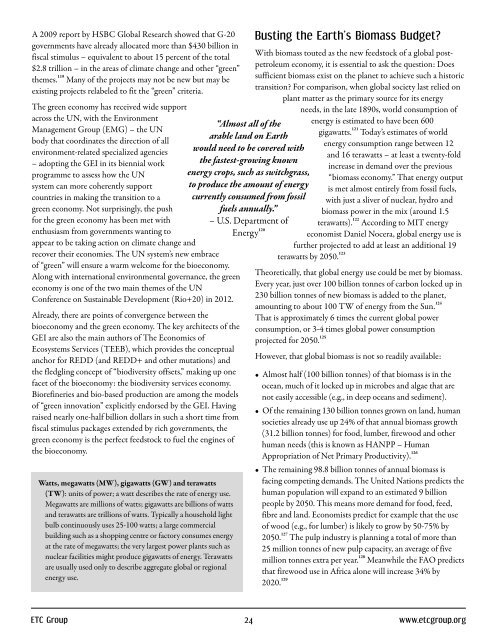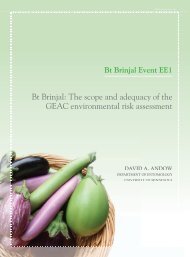English - pdf - 2145 Kb - Biosafety Information Centre
English - pdf - 2145 Kb - Biosafety Information Centre
English - pdf - 2145 Kb - Biosafety Information Centre
- No tags were found...
You also want an ePaper? Increase the reach of your titles
YUMPU automatically turns print PDFs into web optimized ePapers that Google loves.
A 2009 report by HSBC Global Research showed that G-20governments have already allocated more than $430 billion infiscal stimulus – equivalent to about 15 percent of the total$2.8 trillion – in the areas of climate change and other “green”themes. 119 Many of the projects may not be new but may beexisting projects relabeled to fit the “green” criteria.The green economy has received wide supportacross the UN, with the EnvironmentManagement Group (EMG) – the UNbody that coordinates the direction of allenvironment-related specialized agencies– adopting the GEI in its biennial workprogramme to assess how the UNsystem can more coherently supportcountries in making the transition to agreen economy. Not surprisingly, the pushfor the green economy has been met withenthusiasm from governments wanting toappear to be taking action on climate change andrecover their economies. The UN system’s new embraceof “green” will ensure a warm welcome for the bioeconomy.Along with international environmental governance, the greeneconomy is one of the two main themes of the UNConference on Sustainable Development (Rio+20) in 2012.Already, there are points of convergence between thebioeconomy and the green economy. The key architects of theGEI are also the main authors of The Economics ofEcosystems Services (TEEB), which provides the conceptualanchor for REDD (and REDD+ and other mutations) andthe fledgling concept of “biodiversity offsets,” making up onefacet of the bioeconomy: the biodiversity services economy.Biorefineries and bio-based production are among the modelsof “green innovation” explicitly endorsed by the GEI. Havingraised nearly one-half billion dollars in such a short time fromfiscal stimulus packages extended by rich governments, thegreen economy is the perfect feedstock to fuel the engines ofthe bioeconomy.Watts, megawatts (MW), gigawatts (GW) and terawatts(TW): units of power; a watt describes the rate of energy use.Megawatts are millions of watts; gigawatts are billions of wattsand terawatts are trillions of watts. Typically a household lightbulb continuously uses 25-100 watts; a large commercialbuilding such as a shopping centre or factory consumes energyat the rate of megawatts; the very largest power plants such asnuclear facilities might produce gigawatts of energy. Terawattsare usually used only to describe aggregate global or regionalenergy use.“Almost all of thearable land on Earthwould need to be covered withthe fastest-growing knownenergy crops, such as switchgrass,to produce the amount of energycurrently consumed from fossilfuels annually.”– U.S. Department ofEnergy 120Busting the Earth’s Biomass Budget?With biomass touted as the new feedstock of a global postpetroleumeconomy, it is essential to ask the question: Doessufficient biomass exist on the planet to achieve such a historictransition? For comparison, when global society last relied onplant matter as the primary source for its energyneeds, in the late 1890s, world consumption ofenergy is estimated to have been 600gigawatts. 121 Today’s estimates of worldenergy consumption range between 12and 16 terawatts – at least a twenty-foldincrease in demand over the previous“biomass economy.” That energy outputis met almost entirely from fossil fuels,with just a sliver of nuclear, hydro andbiomass power in the mix (around 1.5terawatts). 122 According to MIT energyeconomist Daniel Nocera, global energy use isfurther projected to add at least an additional 19terawatts by 2050. 123Theoretically, that global energy use could be met by biomass.Every year, just over 100 billion tonnes of carbon locked up in230 billion tonnes of new biomass is added to the planet,amounting to about 100 TW of energy from the Sun. 124That is approximately 6 times the current global powerconsumption, or 3-4 times global power consumptionprojected for 2050. 125However, that global biomass is not so readily available:• Almost half (100 billion tonnes) of that biomass is in theocean, much of it locked up in microbes and algae that arenot easily accessible (e.g., in deep oceans and sediment).• Of the remaining 130 billion tonnes grown on land, humansocieties already use up 24% of that annual biomass growth(31.2 billion tonnes) for food, lumber, firewood and otherhuman needs (this is known as HANPP – HumanAppropriation of Net Primary Productivity). 126• The remaining 98.8 billion tonnes of annual biomass isfacing competing demands. The United Nations predicts thehuman population will expand to an estimated 9 billionpeople by 2050. This means more demand for food, feed,fibre and land. Economists predict for example that the useof wood (e.g., for lumber) is likely to grow by 50-75% by2050. 127 The pulp industry is planning a total of more than25 million tonnes of new pulp capacity, an average of fivemillion tonnes extra per year. 128 Meanwhile the FAO predictsthat firewood use in Africa alone will increase 34% by2020. 129ETC Group 24 www.etcgroup.org











